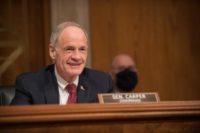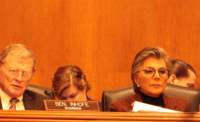Federal Legislation
Senate Committee Clears New Water Resources Development Bill

Carper says climate-change impact will make Corps projects more important.
Photo courtesy Senate Environment and Public Works Committee
A key federal infrastructure bill has moved forward, with Senate committee approval of a new Water Resources Development Act. The WRDA would authorize about $2.3 billion in federal funds for new U.S. Army Corps of Engineers projects around the nation.
Besides the funds for projects, the bill, which the Senate Environment and Public Works Committee approved unanimously on May 22, would change the cost-sharing ratio for inland waterway projects. [View bill summary here.]
In his opening statement, Committee Chairman Tom Carper (D-Del.) said that the Corps projects provide "critical infrastructure" for communities around the country.
"As sea level rise–driven by climate change and extreme weather events–increasingly threatens our communities and their economies, the Corps' work will take on even greater importance," Carper added.
In fact, seven of the eight new or modified projects the bill would fund deal partly or totally with greater protection from hurricanes, floods and other storms.
By far, the largest project item in the bill is $1.7 billion for a coastal protection plan on the South Shore of New York City's Staten Island. The federal funds would be augmented by about $620 million in nonfederal funds, according to ENR’s calculation.
WRDA funding is authorizations from Congress and therefore subject to annual appropriations.
'Modest' Number of Projects
The number of projects is a "fairly modest addition" to the Corps project backlog, says Mike Strachn, a senior adviser with Dawson & Associates, a water resources and permitting consulting firm. The 2022 WRDA had 25 projects.
To be included in a WRDA bill, a project must receive a positive recommendation from the Army's Chief of Engineers.
In coming months, other projects may get "chief's reports" before the 2024 WRDA is enacted.
"My gut tells me, through experience, that there might be a handful," says Strachn, a former Corps civil works official.
The new bill also authorizes 62 new feasibility studies and 11 project modification studies.
Cost-share Shift
Besides the project funding, the committee's WRDA also has a variety of policy-related provisions. Perhaps the most significant is a change in the cost-sharing formula for river locks and dams and other inland waterway projects.
Currently, the general fund covers 65% of those projects' costs and the Inland Waterways Trust Fund provides the other 35%. The trust fund is supported by proceeds from a diesel fuel tax paid by barge companies.
Under the Senate committee bill, the funding split would change to 75% general fund and 25% trust fund. Moreover, the shift would be permanent.
"It's a really big win for us," says Deb Calhoun, senior vice president of Waterways Council Inc. The change would provide funds to address some uncompleted projects and others that are "down the road," she adds.
If a new WRDA is enacted by the end of December, it would continue a 10-year streak of approving water resources legislation every other year.
The committee also approved five other bills, including one to reauthorize the Federal Emergency Management Agency’s National Dam Safety Program through 2029. The program’s authorization lapsed last Sept. 30.
Carper plans to retire at the end of the current Congress. At the committee's voting session, members did approve one amendment to the bill. It was proposed by the panel's top Republican, Sen. Shelley Moore Capito of West Virginia, and would name the measure the Thomas R. Carper Water Resources Development Act of 2024. It was unanimously approved.
"That is very, very kind," Carper said.
The next step for the bill in the Senate is a floor vote.
In the House, the Transportation and Infrastructure Committee's version of a WRDA "is still under development," spokesman Justin Harclerode said via email. He said, "But committee Republicans and Democrats, working together, are making good progress."
Harclerode added that the committee is "eyeing" a potential voting session on its bill in June.
Story updated 5/23/2024






